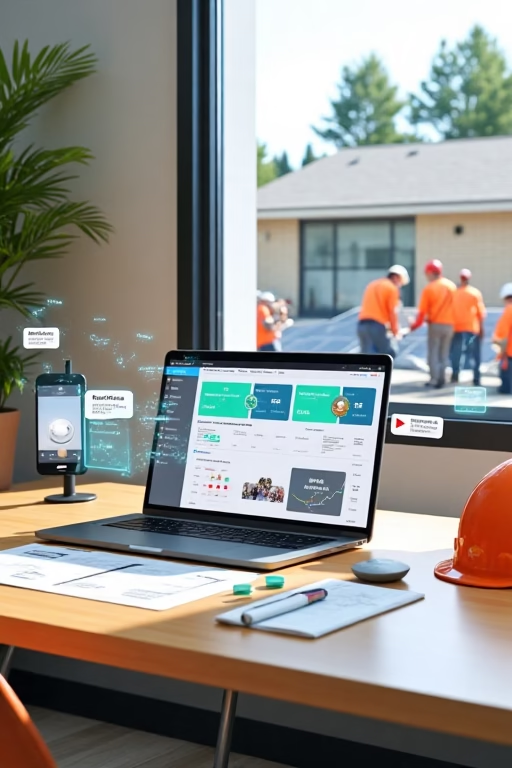Video Marketing for Contractors in 2025
Innovative Video Strategies by Market Wiz AI
Table of Contents
- Introduction: Video Marketing for Contractors in 2025
- 1. Why Video Marketing for Contractors in 2025 Is Essential
- 1.1 Evolving Consumer Expectations
- 1.2 Visual Proof of Expertise
- 1.3 Competitive Differentiation
- 2. Strategic Planning for Video Campaigns
- 2.1 Defining Objectives and KPIs
- 2.2 Identifying Target Audiences
- 2.3 Content Calendar & Budget Allocation
- 3. Types of Videos Contractors Should Produce
- 3.1 Project Showcase & Before-After Tours
- 3.2 Client Testimonial & Case Study Videos
- 3.3 Educational How-Tos & Tips
- 3.4 Behind-the-Scenes & Company Culture
- 3.5 Live Streaming on Job Sites
- 4. Choosing the Right Platforms
- 4.1 YouTube and Long-Form Content
- 4.2 Instagram Reels and TikTok Shorts
- 4.3 Facebook and LinkedIn Video Ads
- 4.4 Integration with Website and Email
- 5. Production Tips & Best Practices
- 5.1 Equipment Essentials for 2025
- 5.2 Scripting and Storyboarding
- 5.3 Lighting, Sound, and Editing
- 5.4 Incorporating Drone Footage and 4K Quality
- 6. Distribution & SEO Optimization
- 6.1 Video SEO Best Practices
- 6.2 Social Media Scheduling & Hashtags
- 6.3 Email Promotions & Embedding Tactics
- 7. Measuring Performance & ROI
- 7.1 Key Metrics to Track
- 7.2 Tools for Analytics and Insights
- 7.3 Iterating Based on Data
- 8. Conclusion & Next Steps
- 25 FAQs
- 25 Extra Keywords
Introduction: Video Marketing for Contractors in 2025
Video Marketing for Contractors in 2025 has become indispensable as digital landscapes evolve. In a world where potential clients expect immersive, authentic visual experiences, contractors must harness video to spotlight their craftsmanship, build credibility, and stand out in a crowded marketplace. This guide unveils cutting-edge strategies, practical tips, and platform-specific insights to help contractors leverage video effectively in 2025.
1. Why Video Marketing for Contractors in 2025 Is Essential
1.1 Evolving Consumer Expectations
Today's homeowners and project managers crave visual proof before hiring a contractor. They research online, scrolling past text-heavy pages to watch dynamic videos that show real project progress. In 2025, video isn't optional—it's the primary medium through which prospects evaluate quality and professionalism.
1.2 Visual Proof of Expertise
Contractors can demonstrate skills more compellingly through video: timelapse installations, 3D render walkthroughs, and drone footage of completed projects. These visuals serve as powerful social proof, enabling prospects to grasp the scope and quality of work at a glance.
1.3 Competitive Differentiation
With many contractors vying for attention, video marketing sets forward-thinking firms apart. A polished project showcase or client testimonial video not only builds trust but also highlights a contractor's edge—be it technological innovation, eco-friendly methods, or unique design aesthetics.
2. Strategic Planning for Video Campaigns
2.1 Defining Objectives and KPIs
Start by pinpointing goals: Are you aiming to generate qualified leads, increase brand awareness, or showcase a specialized service like solar panel installation? Align metrics—video views, watch time, click-through rates, and lead submissions—with these objectives to measure success accurately.
2.2 Identifying Target Audiences
Segment your audience: residential homeowners, commercial property developers, or real estate agents. Each group seeks different information—budget estimates, project timelines, or compliance certifications. Tailor video themes and messaging to resonate with these distinct segments.
2.3 Content Calendar & Budget Allocation
Map out a content calendar for 2025: plan quarterly themes (e.g., energy-efficient renovations in Q1, outdoor living spaces in Q2). Allocate budget for equipment upgrades, editing software subscriptions, or hiring a videographer for high-production-value segments. Even modest investments can yield significant ROI when executed strategically.
3. Types of Videos Contractors Should Produce
3.1 Project Showcase & Before-After Tours
Highlight your portfolio with detailed project tours: film a home remodel from demolition to finished space, using timelapse to condense hours of work into a captivating minute. Include before-and-after split screens to underscore transformations, helping viewers visualize possibilities.
3.2 Client Testimonial & Case Study Videos
Let satisfied clients speak for you. Record short, authentic interviews where homeowners share their experience—emphasize challenges solved, budget adherence, and project highlights. Integrate supporting B-roll footage of the completed work to contextualize their praise.
3.3 Educational How-Tos & Tips
Position yourself as an authority by producing quick how-to videos, like “3 Tips to Extend Your Roof’s Lifespan” or “How to Choose the Right Paint Finish for High-Traffic Areas.” These bite-sized tutorials not only educate but also build trust, making viewers more likely to consider you when they need professional help.
3.4 Behind-the-Scenes & Company Culture
Show the human side of your team: capture a day on the job site, safety briefings, or a team meeting brainstorming solutions. Clients appreciate transparency—seeing your crew collaborate and follow safety protocols reassures them of your professionalism and reliability.
3.5 Live Streaming on Job Sites
Live video offers real-time engagement: stream a roof installation, answer viewer questions on waterproofing, or showcase progress on a commercial fit-out. Use platforms like Facebook Live or YouTube Live to interact directly with your audience, fostering a sense of community and openness.
4. Choosing the Right Platforms
4.1 YouTube and Long-Form Content
YouTube remains the go-to for detailed tutorials and comprehensive project walk-throughs. Create a branded channel, optimize video titles and descriptions with keywords like “Video Marketing for Contractors in 2025” and “home renovation timelapse.” Organize playlists by service category—roofing, kitchen remodels, landscaping—to guide viewers through relevant content.
4.2 Instagram Reels and TikTok Shorts
Leverage 15–60 second Reels and TikTok videos to capture attention quickly. Focus on visually striking moments—color palettes, unique architectural features, or dramatic before-after reveals. Use trending audio and on-screen text to increase discoverability, and include a call-to-action to visit your profile or website.
4.3 Facebook and LinkedIn Video Ads
Facebook’s advanced targeting allows you to reach homeowners in specific neighborhoods or commercial property owners in your region. LinkedIn suits B2B engagements—promote case studies or whiteboard animations on project management methodologies. Include clickable links in video descriptions directing viewers to landing pages or contact forms.
4.4 Integration with Website and Email
Embed videos on your website’s homepage and service pages to boost engagement and SEO. Use video thumbnails as featured images linking to full videos. Incorporate video snippets in email newsletters—show a 15-second teaser and invite readers to click through for the full tutorial or testimonial, driving traffic back to your YouTube or website.
5. Production Tips & Best Practices
5.1 Equipment Essentials for 2025
In 2025, a mirrorless camera with 4K capability and interchangeable lenses is ideal. Pair it with a gimbal stabilizer for smooth motion shots, a compact drone for aerial property views, and a reliable lapel mic for crisp audio. Affordable lighting kits—LED panels with adjustable color temperature—ensure consistent visuals even in low-light construction sites.
5.2 Scripting and Storyboarding
Even short videos benefit from a clear plan. Draft a storyboard outlining each shot—establishing shot, close-ups, B-roll. Write concise scripts and bullet points highlighting key messages. For complex topics (e.g., “How to Waterproof a Basement”), break content into steps and capture each segment systematically.
5.3 Lighting, Sound, and Editing
Natural light is your friend, but supplement with LED panels when outdoors or in shaded areas. Use directional microphones to minimize background noise on busy job sites. In editing, employ quick cuts, captions, and branded graphics to maintain pace. Software like Adobe Premiere Pro or DaVinci Resolve offers advanced color correction and audio balancing to polish your final cut.
5.4 Incorporating Drone Footage and 4K Quality
Drone videography elevates your content—literally. Capture bird’s-eye views of large-scale projects, property overviews, or site progress. Ensure compliance with local FAA regulations and obtain necessary permits. Edit drone clips in 4K and add subtle motion graphics (e.g., project milestones) to emphasize project stages.
6. Distribution & SEO Optimization
6.1 Video SEO Best Practices
Optimize video titles with primary keywords—“Video Marketing for Contractors in 2025” and service-specific terms like “bathroom remodel timelapse.” Add detailed descriptions including project details, locations, and service benefits. Use 3–5 relevant tags and create custom thumbnails showcasing a compelling frame—bright colors, clear text overlays, and your logo.
6.2 Social Media Scheduling & Hashtags
Use tools like Hootsuite or Buffer to schedule posts during peak engagement windows—weekday mornings for LinkedIn, early evenings for Instagram. Include a mix of broad industry hashtags (#ContractorLife, #HomeRenovation) and niche tags (#SolarPanelInstallation, #EcoFriendlyBuild) to reach both wide and targeted audiences.
6.3 Email Promotions & Embedding Tactics
Embed video thumbnails in email campaigns linking to your YouTube channel or landing page. Use compelling subject lines—“Watch Our Latest Project Transformation!”—and include a clear CTA button. Segment lists by interest—for example, send roof replacement videos to subscribers who previously downloaded a roofing guide.
7. Measuring Performance & ROI
7.1 Key Metrics to Track
Monitor metrics such as watch time, retention rate, engagement (likes, comments, shares), and click-through rates on CTAs. For ads, track cost per view (CPV), cost per click (CPC), and conversion rate (form submissions, quote requests). These indicators reveal which videos resonate and which need refinement.
7.2 Tools for Analytics and Insights
Leverage YouTube Analytics for detailed audience demographics and retention graphs. Use Google Analytics to track embedded-video interactions on your site. Social platforms offer native insights—Instagram Insights for Reels, Facebook Page analytics for video posts. Combine these data sources to get a holistic view of performance.
7.3 Iterating Based on Data
Identify underperforming videos—high drop-off rates or low click-throughs—and analyze where viewers lose interest. Adjust content length, pacing, or messaging accordingly. For high-performing videos, replicate successful elements—similar thumbnail design, hook style, or call-to-action phrasing—in future productions.
8. Conclusion & Next Steps
Video Marketing for Contractors in 2025 is not just a trend; it’s an imperative for contractors aiming to stand out, build trust, and drive qualified leads. By strategically planning your video campaigns, choosing the right formats, investing in modern production techniques, and optimizing distribution, you’ll position your business at the forefront of the digital landscape. Embrace these steps to elevate your brand and capture more projects:
- Audit Existing Content: Review any current videos—identify gaps in quality, topics, or platform coverage.
- Develop a Video Strategy: Define your 2025 goals—lead generation, brand awareness, or project showcase—and align KPIs accordingly.
- Invest in Essential Equipment: Secure a 4K camera, a stabilizer, a quality mic, and leverage drone footage when possible.
- Create a Content Calendar: Plan 1–2 videos per month covering different types—testimonials, tutorials, behind-the-scenes, and drone tours.
- Optimize & Distribute: Publish on YouTube, share on social channels with SEO-optimized titles and descriptions, and embed on your website and newsletters.
- Measure & Iterate: Track performance metrics regularly, refine your approach, and scale up the tactics that drive the highest ROI.
Start implementing these Video Marketing for Contractors in 2025 strategies today to ensure your business remains competitive, visible, and trusted in an ever-evolving digital marketplace.
25 Frequently Asked Questions
1. What is “Video Marketing for Contractors in 2025”?
“Video Marketing for Contractors in 2025” refers to using modern video strategies—project showcases, client testimonials, how-to guides, and live streams—to engage potential clients, demonstrate expertise, and generate leads in 2025’s digital environment.
2. Why should contractors invest in video marketing?
Video marketing builds trust through visual proof of your work, enhances brand credibility, caters to evolving consumer preferences for video content, and often yields higher engagement and conversions compared to text or images alone.
3. What types of videos perform best for contractors?
Project showcase videos, Before-After tours, client testimonial interviews, educational how-to tutorials, behind-the-scenes glimpses, and live site streams perform exceptionally, as they combine authenticity with valuable information.
4. Which platforms are ideal for contractor videos?
YouTube is perfect for long-form content and SEO benefits. Instagram Reels and TikTok shorts capture quick attention on social feeds. Facebook and LinkedIn serve targeted video ads to specific demographics. Embedding videos on your website and in email campaigns increases reach and engagement.
5. How often should a contractor publish video content?
Aim for 1–2 high-quality videos per month. Consistency matters more than quantity—regularly updated content keeps audiences engaged and improves SEO over time.
6. Do I need professional videography services?
Professional services can elevate production quality, especially for drone footage or complex editing. However, many effective videos can be produced in-house with a good smartphone, a stabilizer, and basic editing software.
7. How do I optimize videos for SEO?
Use relevant keywords in titles, descriptions, and tags—such as “Video Marketing for Contractors in 2025” and “home renovation timelapse.” Include transcripts or closed captions, create custom thumbnails with readable text, and embed videos on your website to improve dwell time and search rankings.
8. What is the ideal video length?
For social media (Reels, TikTok), keep videos between 15–60 seconds. For YouTube project showcases or tutorials, 3–7 minutes is ideal. Ensure every second adds value to maintain viewer interest.
9. How do I measure video performance?
Track metrics like view count, watch time, retention rate, engagement (likes, comments, shares), click-through rate on CTAs, and conversion events (contact form submissions). Use platform insights and Google Analytics for a comprehensive view.
10. What equipment do I need?
Essential gear includes a 4K-capable mirrorless camera or high-end smartphone, a tripod or gimbal stabilizer, a lapel or shotgun microphone, LED lighting panels, and optionally, a drone for aerial shots.
11. How can I incorporate drone footage?
Use drone to capture aerial property overviews, progress footage of large-scale projects, and compelling before-after comparisons. Ensure you comply with local aviation regulations and secure necessary permits.
12. What editing software is recommended?
Adobe Premiere Pro and DaVinci Resolve offer robust features for professional edits. For simpler workflows, Final Cut Pro (Mac) or even mobile apps like LumaFusion (iPad) suffice for on-the-go editing.
13. How do I script tutorial videos?
Outline key steps: introduction (what problem you’re solving), demonstration (step-by-step process), and conclusion (summary and call-to-action). Use bullet points rather than full scripts to keep narration natural and authentic.
14. How important are captions and transcripts?
Captions and transcripts improve accessibility for viewers who watch without sound and enhance SEO by providing text searchability. Always include them, especially for tutorial and testimonial videos.
15. How do I promote my videos effectively?
Share on social media at peak engagement times, embed on relevant website pages, include in email newsletters, and leverage paid video ad campaigns on YouTube, Facebook, or LinkedIn to expand reach.
16. How do I plan a video content calendar?
Create a spreadsheet listing video topics, target release dates, platforms, and responsibilities. Assign deadlines for scripting, filming, editing, and publishing to ensure consistent output.
17. What are common mistakes to avoid?
Avoid lengthy intros—hook viewers within the first 3 seconds, neglecting SEO best practices, ignoring mobile optimization (vertical format), and failing to include clear calls-to-action that guide viewers to the next step.
18. How do I repurpose videos?
Convert webinar recordings into short tutorial clips, extract key statistics for social media quote posts, transform project tours into before-after images for Instagram, and compile testimonial snippets into a highlight reel for your website.
19. Should I run video ads?
Yes—video ads on YouTube, Facebook, and LinkedIn can amplify reach. Target specific demographics, retarget website visitors, and use lookalike audiences to find prospects similar to your best clients.
20. How do I handle client privacy?
Obtain signed consent forms before featuring clients or their properties on camera. Blur faces or identifying details if requested, and respect any confidentiality agreements related to high-profile projects.
21. Can I live stream on job sites?
Live streaming on platforms like Facebook and YouTube offers real-time engagement. Ensure safety—secure a stable camera setup, wear appropriate protective gear, and communicate any potential disruptions to viewers.
22. How do I integrate video into my website?
Embed videos on service pages, homepage sliders, and blog posts. Use a video sitemap to help search engines index your content. Include a visible play button on your homepage to attract immediate attention.
23. How often should I update old videos?
Review and refresh cornerstone videos every 6–12 months—update project information, add new B-roll, and adjust calls-to-action. Republish with the current date to boost SEO signals and maintain relevance.
24. How do I optimize videos for mobile viewers?
Use vertical or square aspect ratios for social platforms. Keep text overlays large and readable, avoid long pauses, and ensure quick load times. Mobile-first editing tools help streamline this process.
25. Where can I find more resources on Video Marketing for Contractors in 2025?
Visit Market Wiz AI’s blog for in-depth tutorials, downloadable video production checklists, and industry-specific case studies. Download our “2025 Contractor Video Marketing Workbook” for templates and planning guides.
25 Extra Keywords
- contractor video marketing strategies 2025
- construction video SEO tips
- home renovation video ideas
- drone footage contractor marketing
- contractor YouTube channel setup
- Instagram Reels for construction
- TikTok for contractors 2025
- video campaigns for builders
- project showcase video tutorials
- client testimonial filming guide
- video editing software contractors
- 4K video best practices
- youtube SEO for contractors
- facebook video ads for builders
- linkedin video marketing construction
- embed videos on contractor website
- video content planner for contractors
- equipment checklist for contractor videos
- lighting and sound tips for job sites
- mobile-first video production
- video analytics tools 2025
- contractor video conversion metrics
- live streaming job site safety
- video marketing ROI calculation
- Market Wiz AI video resources

















